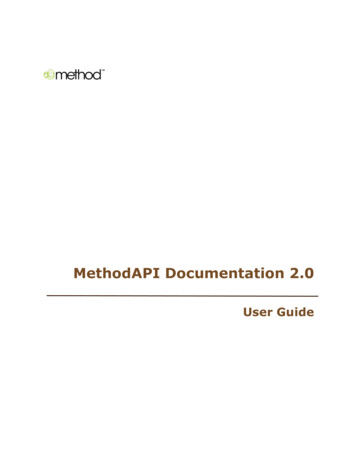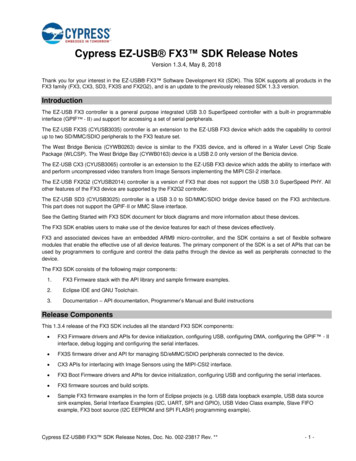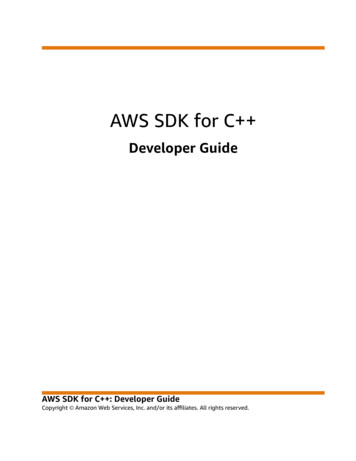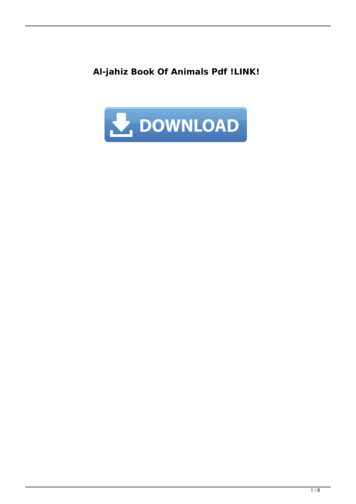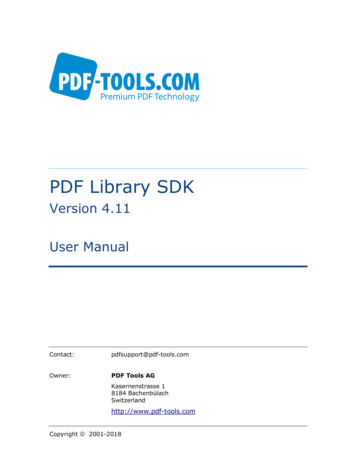
Transcription
PDF Library SDKVersion 4.11User ManualContact:pdfsupport@pdf-tools.comOwner:PDF Tools AGKasernenstrasse 18184 pyright2001-2018
PDF Library SDK, Version 4.11Page 2 of 24June 14, 2018Table of Contents1Introduction . 42Overview . 43Core Classes . 153.163.173.183.193.204PDFile.5Reading from a PDF File .5Writing to a PDF file .6Memory based Input/Output .7Standard Security Support .7Methods and Attributes .7PDObj .8PDValue.8PDDictionary .9PDFInput .9PDFOutput . 10PDPage. 11PDFont . 11PDCopyObj . 12PDAnnotIterator . 12PDAction and Subclasses . 12PDAnnot, PDAnnotData and Subclasses . 12PDOutln . 13PDXObj, PDXSource . 13PDStream . 14PDPgStream . 14PDFontDict . 14PDTextState . 15PDTextToken . 15PDTextScanner . 15Classes of “PDPTDoc” Module . 154.14.24.34.44.54.64.74.8PTInputDoc . 15PTPrintDoc . 16PTFontRsc . 16PTFontEntry . 16PTPrintPage. 16PTAnnotStore . 16PTPageDir . 17PDEnhancedTextScanner . 175Linearization . 186Sample Applications . 186.16.26.3pdls . 18pdinfo . 18pdobj . 18PDF Tools AG – Premium PDF Technology
PDF Library SDK, Version 4.11Page 3 of 24June 14, 20186.46.56.66.76.86.96.107pdcat . 19pdtoc . 19pdxt . 19txt2pdf . 19pdw . 19pdwebl . 20pdsplit . 20Appendix . 217.17.2Things to observe . 21Security . 21Copying. 21Memory Usage . 21Multithreading . 21Error Handling . 21Compiling on MS Windows . 22Using Different Compiler Settings . 22Trouble shooting . 23Compilation with MSVC When Using MFC . 23Text Operator Dependencies . 238Index . 249Licensing . 24PDF Tools AG – Premium PDF Technology
PDF Library SDK, Version 4.11Page 4 of 24June 14, 20181IntroductionThe PDF library originates from a development in early 1995. The library was designedto satisfy the requirements of the former Xerox DPP product, later called XDA (XeroxDocument Assembly). Since then, more and more functionality has been added to thelibrary. It constitutes the core of several own products and has been embedded intovarious third party products.The basic functionality of the PDF library is to read in data from PDF files, present themin structured objects, and create new PDF files where such objects can be written to.The PDF library models the contents of a PDF file by C classes. You may want toread Adobe’s PDF specification to gain the necessary background.The PDF Library SDK supports PDF versions 1.1 which relates to Adobe Acrobat 2.1 upto 1.6 that comes with Adobe Acrobat 7.0.2OverviewThe core classes of the PDF library comprise PDFile that encapsulates a PDF file andPDObj, which models an object in the PDF file.The content of PDF objects is reflected by a hierarchically composed value (PDValue).A value can be a dictionary (PDDictionary), an object reference, or a another type likestring or number. Dictionaries are collections of keys and associated values. Someobjects have a data stream that belongs to them. This data is also attached to anobject of class PDObj.The library contains auxiliary classes to implement input from PDF files (PDParse,PDScan); they should be of no interest to a user of the library.The basic functionality provided with PDFile and PDObj (file pdfile.h) is extended byderived classes. PDFInput is derived from PDFile with enhancements for basically twoissues: copying pages to a PDF output file, and cashing objects in memory. Readingand writing of PDF files from/to memory is also supported.PDFOutput is also derived from PDFile, but designed for enhancements that apply tooutput to a PDF file.Note that the PDF library does not permit input and output at the same time to thesame file. There is no updating of existing files, as the PDF standard would permit. Afile that is written to is always created from scratch.PDPage is a class derived from PDObj that models more precisely the behaviour ofpage objects. It is related to PDFInput, since PDFInput requires objects to be of thisclass for the CopyTo functionality. PDPage several enhancements over PDObj likeadding contents, annotations, fonts or XObjects. Retrieval of page related informationitems is also supported.Support for transforming a page from an input file into an XObject that can be used foroutput is included in „pdxobj.h“ through the classes PDXObj and PDXSource.Outlines (i. e. bookmarks) can be constructed and added to an output file. This supportis found in „pdoutln.h“.PDF Tools AG – Premium PDF Technology
PDF Library SDK, Version 4.11Page 5 of 24June 14, 2018Streams are used to carry many different kinds of data, notably the contents of apage. If you need access to an encoded contents stream, or if you would like to placetext on a page, you use the classes PDStream or PDPgStream (pdstream.h).3Core Classes3.1PDFileThe class PDFile models a PDF file that is either being read from, or one that is beingwritten to. It is not possible to alter an existing PDF file on disk; neither is it possible tomake any changes to an object once it has been written out to a (new) PDF file. Theclass declaration is located in the header file „pdfile.h“.Reading from a PDF FileReading from a PDF file is performed with the following steps:PDFile theFile;PDObj t.Read(theFile, theFile.GetInfoId());After declaring appropriate variables, you gain access to information in the PDF file byfirst opening the file and then read from it by using the Read method (that belongs tothe object in this sample here). The Read method fills in the data of „theObject“.An alternate method to read data from the file is using the ReadObj method of PDFile:PDObj *pObj theFile.ReadObj(1);When you use ReadObj, a new object is dynamically created and returned to you withthe data filled in. Note that this sample carries some dangers: we ask for object with id1, but this object may not exist unless we have good reasons to believe this. ReadObjwould return a NULL pointer in this case.Please refer to the description of the PDObj class below for more information ongaining access to information within an object.The ReadPages method can be used to traverse the pages tree of a PDF file. Ontraversal of the pages tree, OnReadPages is called; when a page is encountered,OnReadPage is called. The "pdls" sample shows how these methods can be overriddento add functionality.Generally, page numbering starts at zero. This applies e. g. whenever a page isreferred to by its number, as in link annotations. The member m curPage counts pagenumbers before OnReadPage is called. Therefore, m curPage contains the number ofpages encountered so far and starts at one rather than zero.PDF Tools AG – Premium PDF Technology
PDF Library SDK, Version 4.11Page 6 of 24June 14, 2018Writing to a PDF filePDF files can be written to in a variety of different ways. Be careful to obey the Adobestandards, it is easy to write messy files. The PDF Library SDK does not care muchabout the semantics of objects!The creation of a PDF file happens according to the following scheme:PDFile Write(“%comments are allowed“);theFile.WriteLn();OBJID id ();The Write method is overloaded to accept several parameter types: PDObj, CString,char*, numbers, PDValue, PDDictionary, arrays of bytes. WriteRef writes an objectreference, WritePageRef writes an object reference to a page.A PDObj is usually written to a file after reading it from another file and eventuallymodifying it. In this case, think about the id of this object: most of the time, it will notbe the id it carries in the input file. If it is not related to anything you have written orare going to write, you must give it a new identification using the CreateObj method. Itshould not contain any object references inside.If it is related to other objects that come from the same input file, i. e. if it isreferenced from such objects or refers itself to such objects, you want to use the id„adoption“ mechanism supplied in the PDF library. You have to replace the object idand all references it contains using the Adopted method. The PDCopyObj class helpsyou to do this for a whole hierarchy of objects.Id adoption is a feature that maps object ids from a particular id scope - that of achosen input file - to the scope of the output file. Whenever you choose a new inputscope, you do this by a call to the ReserveIds method of the output file. It is notpossible to save a mapping and restore it again, for example to merge pages of twoinput files. However, you can insert objects (pages) programmatically by using theCreateObj method that reserves new object ids.Strings, numbers, PDValue and PDDictionary objects are written when you composenew objects as in the sample code above. PDF string values deserve your specialattention; they are enclosed in left and right parentheses. If the text contains specialcharacters - among them parenthesis - it has to be encoded appropriately. For thispurpose, the PDF library supplies the functions MakePDFString and DecodePDFString(in pdfile.h).PDF Tools AG – Premium PDF Technology
PDF Library SDK, Version 4.11Page 7 of 24June 14, 2018Memory based Input/OutputThe PDF Library SDK supports also reading or writing PDF files from/to a memorybuffer.If you choose for example to store a PDF file as a blob in a database, you can retrieveit to a memory buffer and open it using PDFile::MemOpen. An other use case is whenyou prefer to work with memory mapped files.A web server application may not want to create the PDF file in the file system, butpipe the PDF file in response to a CGI or servlet request back to the browser. In thiscase, the output can be generated into a memory buffer by using thePDFile::MemCreate function. Note that you must Close the file to complete the outputbuffer. After that, you can use MemBuffer() and MemLength() to refer to the outputbuffer. The space for the output buffer is managed by the PDFile object and will befreed in the destructor of the object.Standard Security SupportSupport for standard security based on the encryption technique described in theAdobe PDF specifications is optional. This means that the API calls are present, butonly functional with the corresponding code module contained in the library.The functionality dealing with security is encapsulated in the classes PDFile and PDObj.The PDFile::SetUserPassword and PDFile::SetOwnerPassword methods are used toprovide password information after opening (or creating) a PDF file. The security flagsare accessed via PDFile::PermissionFlags.Since string and stream output is encrypted in secured files, you have to usespecific methods designed for these data types. PDFile::WriteEncoded will encryptdata and then encode it. If you have used previous versions of the PDF library, youhave to replace calls like PDFile::WriteString(“(some string data)”)PDFile::WriteEncoded(“some string data”);thethewillbyPDF data is usually read via a PDObj object. This class has methods to facilitateencryption (for output) and decryption (for input), such asDecodeString, EncodeStringDecryptStream, EncryptStreamDecryptValue, EncryptValueThe data of a PDObj can be either decrypted (plain text) or encrypted, and care shouldbe taken not to confuse these states. The PDObj::Read method will read in the datafrom the file and leave it encrypted. All other methods providing PDObj (or PDPage)objects will automatically decrypt the data. The PDObj::Write method willautomatically encrypt the data.Methods and AttributesThe class definition of PDFile is located in the file pdfile.h. It contains comments for themethods and attributes that may be of interest to an application programmer.The destructor of PDFile takes care to free any dynamic memory associated with thePDFile object (m template, closing the file to free the file handle, m idMap, m index,PDF Tools AG – Premium PDF Technology
PDF Library SDK, Version 4.11Page 8 of 24June 14, 2018m parent, m threadArr).The close method frees m parent, m idMap, file handle, m index, m threadArr.3.2PDObjEverything contained in a PDF file except header and trailer is a hierarchy of objects.The origin of all objects is the root object. PDObj objects carry their object id in them id attribute. The information contained in the object is stored in the „value“ part (aprotected attribute that you access using „AttrVal()“). Some objects have stream data;this data is attached to the value attribute (see PDValue below).The class PDObj encapsulates all kinds of these objects. It discerns two specific typesof objects that make up the pages of the document; the other object types are handledgenerically.The type of an object is stored in the „m kind“ attribute. This attribute is actuallydetermined from the value of the object (according to the /Type entry in thedictionary). Setting m kind has no effect, it is just an indication for the efficienttraversal of the pages tree.3.3PDValueThe PDValue class models all possible variants of simple or aggregated data thatmakes up the information contained in an object - at the root level or contained in anaggregate part of it.The basic data types are object references, names, numbers, and strings. An objectreference is something like „1 0 R“, a name is e. g. „/Page“ (in a dictionary like /Type /Page ), a number is an integer number as in /Length 59 , an a stringexample is /Title (De bello gallico) /Author (Julius Caesar) . The numerical datais stored in the m num attribute, but also as string in m string.Aggregate types are arrays and dictionaries. Arrays are implemented as linked lists ofPDValue objects, using the m nextEl attribute. The m num attribute of the arrayobject contains the number of elements in the array. Note that array elements can beany basic data type or a dictionary. Starting with V1.4, arrays elements can also bearrays. In this case, make sure to use the access methods (GetFirstEl, GetNextEl). Thebehaviour with respect to the member variable m nextEl has been preserved forcompatibility with earlier versions of the library.For a description of dictionaries, please refer to the next section.Instances of the class PDValue can store a PDF stream, e. g. in the case of /Contentsobjects. In this case, they contain a dictionary which itself contains a /Length key andpossibly /Filter keys. To construct such a class instance, you can use the methodAssignStream. This method will automatically set the /Length key in the dictionary.(Make sure m dict has been initialised before). It does not set or remove any encodingentries in the dictionary. Make sure these entries are set corresponding to the contentsof the stream that you assign.PDF Tools AG – Premium PDF Technology
PDF Library SDK, Version 4.11Page 9 of 24June 14, 20183.4PDDictionaryDictionaries are an aggregation of keys and associated values. Some common keys arepredefined in the PDF library; in general, there is no limitation to keys, and the libraryhandles this dynamically.To gain access to the value associated e. g. with the /Length key, you would use eitherPDDictionary *pDict .;PDValue *pVal pDict- GetAttrVal(PDDictionary::aLength);orPDValue *pVal pDict- GetAttrVal(“/Length“);To add another entry to an existing dictionary, you write the following code:pDict- SaveAttrVal(“/Author“, pVal);Keys are unique in a dictionary; if you apply SaveAttrVal to a dictionary with a key thatalready exists, the previous value is deleted and the new value is stored. Note that thevalue pointer that you pass is stored in the dictionary, and that the dictionary objectsreceives control over the value object. Before storing a value, you must allocate itusing the „new“ operator, and you may not delete it any more. You can delete thedictionary object, and this will automatically delete any values stored in it.The DeleteAttr method deletes an entry from a dictionary. ChangeName allows you tochange a specific key in the dictionary - this is more efficient than deleting and addingit again (you will hardly need this feature; it is used in one special case in the PDFlibrary).To traverse all keys and corresponding values in a dictionary, you use GetVal. ThefpPos parameter works like an index, it starts at 0. GetVal returns FALSE (0) if theindex runs out of range.3.5PDFInputThe main purpose of the class PDFInput is to selectively copy pages from the input fileto an output file. It allows the modification of the pages on the fly. This is supportedwith an object cache that is also incorporated into PDFInput. Objects can be acquiredselectively for alteration before the standard copy routine handles the page. Duringcopy, the objects that are kept in the cache are used (rather than the original onesthat would be read into memory from the input file).The declarations for PDFInput are located in the header file „pdpage.h“.The CopyTo method works in conjunction with ReadPages, OnReadPage andOnReadPages. The latter methods contain the code that actually deals with copying.This means that you cannot use PDFInput to simply traverse the pages tree of a fileand NOT copy pages to another file. You can derive a class from PDFInput, where youoverride ReadPages, OnReadPage and OnReadPages.The sample program "pdcat" uses PDFInput to copy pages while doing somemodifications to them.How does PDFInput workPDFInput incorporates a cache of objects that have been read using its GetObj method.PDF Tools AG – Premium PDF Technology
PDF Library SDK, Version 4.11Page 10 of 24June 14, 2018GetObj first looks at the cache (implemented by m objOnHold); if the object is there,a pointer to it is returned. Otherwise, the object is read from the file and stored in thecache - and the pointer is returned. PeekObj can be used to check the cache for anobject without reading it from the file.The cache can be flushed either by using the ReleaseAll method or by using theReleaseObj method. ReleaseObj can either release only the object that is specified, oralso any other objects that are referenced from this object. The reference chain stopswhen a /Page or /Pages object would be reached (following link annotations and/Parent links would result in unpredictable behaviour).Copying works as follows: the method CopyTo initializes the state of the membervariables of PDFInput such that the methods dealing with page traversal select thedesired pages. The ReserveIds method of the output file is called to flush a potentiallyexisting id mapping table and reserve space for the one to come. Since CopyTo can becalled several times in sequence, the array indicating which objects already have beencopied is cleared. If no object template has been stored, CopyTo installs a PDPagetemplate.ReadPages, OnReadPages and OnReadPage are the methods that are called to traversethe pages tree of the input file. When only part of the pages are copied, the pages treeis modified to contain only the desired part of the pages. To this end, PDFInputrequires PDPage objects to be read, because it makes use of the RemoveKid method.This method modifies recursively the /Pages object on the way up to the pages root.This is possible because traversal starts at the root object and recursively goes downto the leafs of the tree. When a leaf or sub tree that has to be omitted is found, allnodes up to the root are present on the stack and are linked via the m parent memberof PDPage.Please note that CopyTo requires objects to be of class PDPage (or something derivedfrom that).As an alternative to the CopyTo method, you can use “CopyFew”. This method doesnot traverse the whole pages tree, but rather descends the tree to a random page (orsome random pages) to copy it. CopyFew is therefore appropriate to extract somepages from a large document.Please be aware of a conceptual problem when copying only a range of pages: it ispossible that these pages contain link annotations which refer to pages that are notcopied. It is up to the PostCopyPage method to remove such annotations. If the pagecontains form fields that should be copied, there is a possible problem of having moreinstance of that field on pages that are not copied. The AcroForm dictionary must bereconstructed therefore. This is not yet automatically supported by the PDF library.3.6PDFOutputThe class PDFOutput is a rather tiny extension of PDFile. It stores objects of classPDStoredObj until after all other objects have been written to the output file. Byoverriding the WriteContents method of PDFile, PDFOutput triggers at this moment theoutput of the stored objects.You would use stored objects as a convenient way to remember objects you want towrite to the PDF file for which you do not have everything ready. This is the case forlink annotations to pages whose id is not known yet, if you want to use the id for thedestination (which is the more efficient and also more safe than using the pagePDF Tools AG – Premium PDF Technology
PDF Library SDK, Version 4.11Page 11 of 24June 14, 2018number).3.7PDPageThe class PDPage is derived from PDObj and incorporates functionality related to /Pageor /Pages objects.The following features are related to these objects:adding a content object (to add text or graphics to a page)removing an entry from the page's dictionary (e.g. to strip off the annotations)add an annotation to the pageadd a font to the page's resources (which is required if that font is used in acontent of the page)add an /XObject to the page's resourcesfind the object in the pages tree that contains the MediaBox definition that appliesto a pageget the rectangle of the media box that applies to a pageset the media box rectangle of the page (add it if it is defined elsewhere, or changeit)remember the parent objectremove a page or sub tree of pages from a /Pages objectTo obtain objects of class PDPage rather than PDObj, you must use thePDFInput(PDFOutput*) constructor unless you do a "CopyTo". The m templatemember of PDFile cannot be set directly to a PDPage object - derive your own class todo this.3.8PDFontTo create a page content with text, you need to refer to a font declaration. The classPDFont which is an extension of PDObj provides this support for the built in fonts likeHelvetica, Times or Courier.A typical scenario for using PDFont isPDFont font;font.Create(“/FX1“, “/Helvetica“);font.Write(output file);In this sample, the object id for the font object is created during the Write method. Analternate way is to create an object id first and then pass it as third parameter toCreate.The SetEncoding methods permit to set one of the standard (built in) encodings or toset a user defined encoding by referring to another PDF object ( /Type /Encoding/Differences [ . ] ; s. txt2pdf sample).The PDFont object can be deleted after Write. Reuse of the PDFont object to create andPDF Tools AG – Premium PDF Technology
PDF Library SDK, Version 4.11Page 12 of 24June 14, 2018write several fonts is discouraged.3.9PDCopyObjThe class PDCopyObj is a helper class that extends the base class PDAttrScan tosupport the copying of an object tree from an input file to an output file. It is used forexample in the context of the CopyTo method of PDFInput to copy everythingbelonging to a page. In the sample (pdcat), there is an example where PDAttrScan isderived not only to do the copy job but also patch certain items on the fly.3.10 PDAnnotIteratorThe class PDAnnotIterator helps to retrieve annotations from pages in a convenientrepresentation (a polymorphic object rather than a general PDValue tree).Currently, the recognition of Text and Link annotations of subtypes GoToR and Launchis supported.Each call to GetNextAnnotData retrieves an annotation and stores it in a dynamicallycreated object according to the type of the annotation. Make sure to delete this objectwhen it is no longer used.3.11 PDAction and SubclassesThe PDF library supports a number of standard action classes, such as „GoToR“(navigate to another page of a PDF file), „Launch“ (activate another applicationprogram), and „URI“ (web links for internet browser navigation).PDAction is an abstract base class, so you will never create objects of that class, butrather deal with one of the subclasses PDLaunchAction, PDGoToRAction orPDURIAction. Objects of this type are found in conjunction with Annotations or bookmarks (outlines).You can retrieve action information from a link annotation object or an outline objectusing the „GetAction“ method of class PDFInput. Note that you are responsible to freePDAction objects created this way to avoid memory leaks.3.12 PDAnnot, PDAnnotData an
read Adobe's PDF specification to gain the necessary background. The PDF Library SDK supports PDF versions 1.1 which relates to Adobe Acrobat 2.1 up to 1.6 that comes with Adobe Acrobat 7.0. 2 Overview The core classes of the PDF library comprise PDFile that encapsulates a PDF file and PDObj, which models an object in the PDF file.


